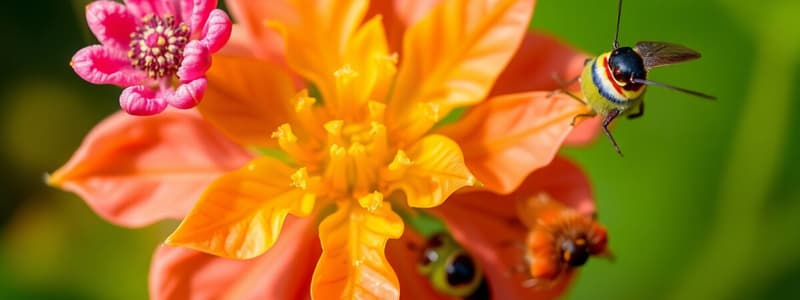Podcast
Questions and Answers
Match the scientific process with its description:
Match the scientific process with its description:
Observation = Using senses to gather information. Experiment = Testing ideas to see what happens. Measurement = Using tools to determine size, quantity, or degree. Recording = Documenting data and results.
Match the type of living thing with its characteristic:
Match the type of living thing with its characteristic:
Plant = Makes its own food using sunlight. Animal = Consumes other organisms for energy. Mammal = Warm-blooded vertebrate with hair or fur Reptile = Cold-blooded vertebrate with scales
Match the concept of force and motion with its definition:
Match the concept of force and motion with its definition:
Force = A push or pull. Motion = A change in position. Gravity = Force that pulls objects toward each other. Friction = Force opposing motion between surfaces.
Match the state of matter with its property:
Match the state of matter with its property:
Match the form of energy with its description:
Match the form of energy with its description:
Match the stage of the water cycle with its description:
Match the stage of the water cycle with its description:
Match the simple machine with its function:
Match the simple machine with its function:
Match the component of the carbon cycle with its role:
Match the component of the carbon cycle with its role:
Flashcards
Scientific Processes
Scientific Processes
Science involves asking questions and finding answers through observations and experiments.
Observations
Observations
Scientists use their senses to carefully observe the world around them.
Force
Force
A force is defined as a push or a pull that can change motion.
Gravity
Gravity
Signup and view all the flashcards
States of Matter
States of Matter
Signup and view all the flashcards
Energy
Energy
Signup and view all the flashcards
Water Cycle
Water Cycle
Signup and view all the flashcards
Simple Machines
Simple Machines
Signup and view all the flashcards
Study Notes
Scientific Processes
- Science involves questioning the world and finding answers through observations and experiments.
- Scientists meticulously observe using their senses.
- Experiments allow scientists to test ideas and understand cause-and-effect relationships.
- Scientists employ tools like rulers, thermometers, and magnifying glasses for precise measurements and observations.
- Recording observations in notebooks is crucial for documenting experiments and sharing findings.
Classifying Living Things
- Living organisms are grouped based on shared characteristics.
- Plants and animals are both living things.
- Plants require sunlight, water, and air for growth and produce their own food.
- Animals obtain energy by consuming food and cannot produce their own food.
- Living things are categorized in various ways, like plants vs. animals and mammals vs. reptiles, based on similarities.
Force and Motion
- Force is a push or a pull.
- Motion is a change in position.
- Forces can change the speed or direction of objects.
- Gravity is the force pulling objects towards Earth.
- Friction resists motion between surfaces in contact.
Matter
- Matter occupies space and possesses mass.
- Matter exists in three states: solid, liquid, and gas.
- Solids maintain a fixed shape and volume.
- Liquids maintain a fixed volume but not a fixed shape.
- Gases have neither a fixed shape nor volume.
- Matter transitions between states with changes in temperature.
Energy
- Energy is the capacity to perform work or cause change.
- Energy manifests in various forms, such as light, heat, and sound.
- Plants harness solar energy to produce food.
- Animals obtain energy from consuming food.
- Energy can be transferred between objects.
Cycles in Nature
- The water cycle depicts water's movement from Earth's surface to the atmosphere and back.
- Stages include evaporation, condensation, and precipitation.
- The carbon cycle illustrates carbon's movement through the environment, encompassing living organisms.
- These cycles are essential for environmental health.
Simple Machines
- Simple machines simplify tasks.
- Examples include levers, pulleys, and inclined planes.
- Simple machines modify force size or direction.
- Employing simple machines reduces the effort needed for tasks.
Earth and Space
- Earth is a planet orbiting the sun.
- The sun is a star.
- Planets in our solar system revolve around the sun.
- Earth's tilt causes different seasons in various parts of the world.
- The moon orbits Earth.
Studying That Suits You
Use AI to generate personalized quizzes and flashcards to suit your learning preferences.




